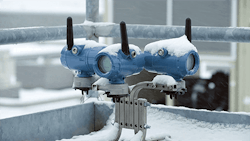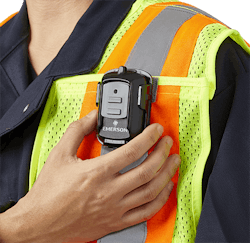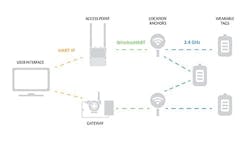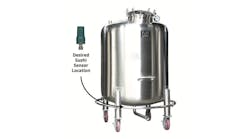The planning of an integrated safety system that includes all elements of plant monitoring, from toxic gas to personnel location and status, can seem a daunting task. However, quickly advancing digital technologies can make it simpler, faster and more cost-effective than doing so even a year ago. Now, it is possible to integrate many systems, such as basic process control, equipment condition monitoring, data historian applications and more, that once were separate. Linking these systems enables data sharing at a central location to build a more complete picture of operations. Many of the improvements that facilitate this integration are new networking technologies, especially wireless ones.
Separation no longer necessarily makes a facility safer. Capturing data from safety systems now is possible without interfering with critical functions such as pressure relief valves on a reactor filled with toxic product. Having real-time access to the health and status of that safety valve creates peace of mind and, in fact, can improve safety because such data combined with other process data can better predict stresses on safety systems.
A closer look at two different scenarios gives a good idea of how and where extending and integrating safety-related functions ultimately can enhance safety in and around a facility.
Monitoring Toxic Gas
Such monitoring often just complements safety-instrumented systems. A gas monitor will sound an alarm, alerting workers to a problem, but won’t close a valve or shut down a process. This is where integration and automation can provide value. An integrated system can do more than create awareness of a problem — it can trigger a direct action to mitigate the problem.
Figure 1. A wireless toxic-gas detection system can use an architecture such as this.
For example, if a faulty valve causes a toxic gas release, an adjacent pressure transmitter tied into the process automation system can register the change in pressure in the system and might trigger a safety instrumented function in response. However, adding new wiring for toxic gas monitors can be cost-prohibitive and challenging if space is tight or sensors require placement at hard-to-reach locations. Using wireless devices can eliminate these issues, allowing applications not previously considered. For instance, a plant operator can install monitors that communicate via an existing WirelessHART network (Figure 1).
Some current gas-monitoring instruments are modular, designed for wireless operations, and powered by long-lasting internal batteries that eliminate the need for new wiring. Emerson’s are designed specifically for use in petrochemical plants, refineries and similar operations and can withstand temperature extremes, exposure to the elements (Figure 2), and remain operational in most hazardous areas such as IECEx Zone 0 and CSA and ATEX equivalents.
Locating Personnel
Another important application of wireless monitors is to bolster personnel safety by providing up-to-date information on worker location. When seconds count in an emergency, knowing exactly where someone is can improve incident response and outcome. However, adopting a location monitoring system historically has been cost-prohibitive and difficult to design and implement. Process plants, for instance, often contain large vertical structures spanning a massive square footage, and can involve harsh temperatures and hazardous conditions.
Fortunately, today’s wireless location sensors can cost-effectively provide spatial and time resolution sufficient for emergency response. Emerson’s safety-oriented location systems for personnel exemplify the main functions now available:
Figure 2. Available devices can withstand temperature extremes and exposure to the elements.
• By pushing a button on a tag pendant (Figure 3), a worker can signal an injury or emergency in progress and provide his or her exact location.
• Geofencing shows whether an individual has moved into an area where the person doesn’t belong due to hazardous conditions.
• Safety mustering indicates to first responders that people in the plant have moved to a designated safe area during a drill or actual emergency.
• Low activity alerts aid in detecting a fall or other emergency where the person is not moving.
Moreover, modern wireless sensors avoid the issues posed in the past — such as investing in expensive industrial routers to ensure reliable data transmission and the need to hardwire them, which again brings up the issue of running wire in potentially hard-to-reach places. Cellular, global-positioning-based systems also rely on external networks for security and struggle with locate-reliability in dense infrastructure.
Wireless Communication
Location sensors such as those offered by Emerson communicate via WirelessHART; many plants already are running WirelessHART networks to collect data from other transmitters and systems, e.g., flow meters, not just for control but also for analysis to give efficiency and sustainability insights on the process in relevant time frames. That same network architecture can serve to host an effective, secure WirelessHART-based location system.
Figure 3. Pushing a button enables a worker to signal an injury or emergency as well as the person’s location.
Building a location monitoring system using WirelessHART does involve more than just adding more process instruments to an existing network. A good location monitoring system using triangulation requires a beaconing device, which we call a location anchor. Plant workers must wear lightweight tags that are paired with the anchors. These wearables must be designed not to interfere or hinder turnaround or maintenance tasks in the facility. A server for the user interface (UI), plus adequate WirelessHART gateway capacity also are necessary. For mobile interface throughout the plant with the location system, teaming plant WiFi with the WirelessHART network will allow use of a tablet, mobile phone or other smart device to respond to emergencies or alerts.
Emerson’s location anchor devices are small (<15-cm diameter), light (<0.5 kg), and self-powered for up to 5 years, which makes them easy to install in all places without requiring additional wiring. The anchors, along with the tags, meet the classification standard to be deployed throughout the plant, Class 1/Div 1 Zone 0. They require very little maintenance and can economically provide full coverage of a facility.
The WirelessHART anchors communicate completely wirelessly with other anchors, the access points, the rechargeable tags worn by each worker, and the network-hosted user interface (Figure 4). The communications network is self-organizing and can adapt to changing conditions without intervention. WirelessHART is proven through 50,000 deployed networks, is highly secure, with multiple authentication and encryption points, and can operate entirely within a corporate network or facility.
Moreover, the software platform, which is preconfigured and ready-to use, includes other applications beyond the location UI to monitor heat exchangers, steam traps, pressure relief valves, cooling towers, pipe corrosion and more. All this makes for a cost-effective and easy-to-implement way to keep personnel safe in a large facility with many potential hazards.
Figure 4. Tags worn by personnel communicate with anchors that, in turn, communicate with gateways and access points.
Extend Your Current Network
An existing WirelessHART network already carries data from field instruments to a main process automation system. Although toxic gas monitoring and location systems do not integrate directly, they exist side-by-side on that same network, bringing relevant data to a centralized system or dashboard.
Data from toxic gas monitors or a location system can be used in conjunction with other systems. For example, an alert from a wireless toxic gas detector might prompt operators to check the location of plant personnel as well as take preventative measures to secure other devices nearby, shutting valves and initiating pre-determined safety protocols to further reduce exposure risks.
Extending an existing network originally conceived to support measurement instrumentation to now support toxic gas monitoring and a location system seems to us a natural part of a facility’s ongoing digital evolution. Improving analytical capabilities with the goal of enhancing plant operations and worker safety makes the investment in toxic gas monitors as well as location devices and anchors a worthwhile one.
KEVIN STULTZ is a global product manager for Emerson, Shakopee, Minn.
JACOB TARDONI also is a global product manager for Emerson in Shakopee. Email them at [email protected] and [email protected].






